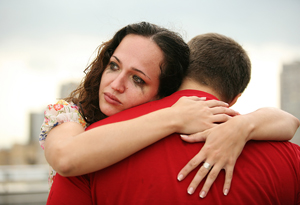Five stages of grief
By Psychologist Colin Matthews
There is no right or wrong way to grieve. For each one of us, it is a very personal experience.
There are, however, recognised patterns in the way that we grieve. These can be loosely identified as follows:
Stage 1: Shock, Denial & Numbness

Where we refuse to believe that the person we care for has died. We need time to process what has happened so that we can begin to make sense of it and the loss we have experienced. This numbness can often help us through the first few days.
Stage 2: Anger
We move to this stage when we begin to understand the reality of the death. We might get angry at ourselves, other people or society in general. We might look for someone to blame and ask why this has happened to us.
Stage 3: Yearning
There is then often a period of yearning or pining where we want the other person back, talk to others about them and remember the times you had together. You might get out old photographs, watch DVDs with the person on them or go places that you would have gone together.
Stage 4: Acceptance & Integration
Where we start to accept the reality of the situation and realise that the person is no longer going to be with us. We have our memories of them but we will now live the rest of our lives without them. Although we may continue to miss our loved one, the feelings of remorse we have begin to lessen and become more manageable.
Stage 5: Moving On
Our lives become more future-orientated. We can begin to enjoy ourselves once more and not feel guilty at planning our future without the person who has died.
Overview
Stages 1-3 are associated with the past and stages 4 and 5 associated with the future. While at any time, where we dwell on the past, our mood is likely to dip, this is more so during the bereavement process. For a period after someone close to us dies, we might find that our mood dips.
GPs sometimes prescribe anti-depressants at this time, recognising that people may be temporarily depressed at the death of a loved one. Some people will cope with this period by distracting themselves from their loss by keeping themselves busy. Others will want to talk.
Our mood is likely to reach its lowest point at the end of stage 3 and the beginning of stage 4, theadjustment from living in the past to living for the future. As we progress through this stage and into stage 5, it is likely that our mood will also begin to lift.
The void created by the death of our loved one is gradually being filled by other things in our life. Each of us generally sees a reason for living. This can be severely tested by the death of someone close and we may need time to rethink our meaning and purpose. Grieving, therefore, is also a period during which we can begin to reconstruct what life is about for us and make it meaningful once again.
The stages illustrated above are not necessarily experienced in a specific order and it may be that parts of each are experienced all at the same time. Generally, however, you would tend to feel more in one stage than in another.
For example, perhaps more angry or more accepting. Events after the death such as an anniversary, a newspaper story or an inquest may place you temporarily back in one stage. There is also no set time for the process of grief. For some, this may be months, for others, several years, particularly where the circumstances of the death have been tragic.
Psychologically, however, if someone is ‘stuck’ in a grieving process for more than two years, we would recommend that they speak to their GP.





